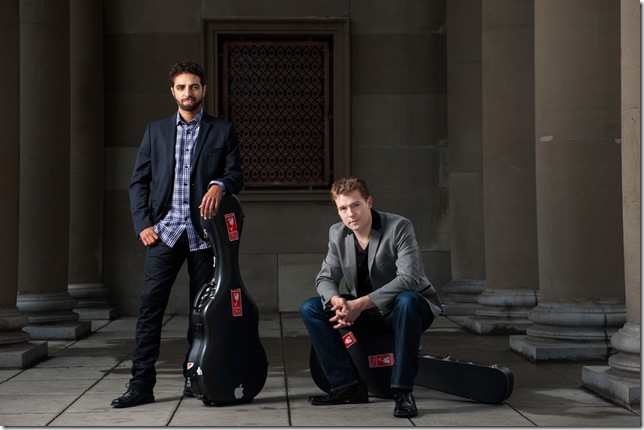Christopher Mallett and Robert Miller, who call themselves DuoSF, are no ordinary self-taught hotshot young guitar players.
Appearing in the Young Artists Series at the Rinker Playhouse of Kravis Center on April 7, they brought their gentlemanly and highly cultured approach to this string strumming art we all associate with Spain. Andres Segovia was the leader, Miller and Mallett his disciples.
Mallett, the darkly handsome one, has a master’s from the prestigious Yale School of Music and Miller, the fair-haired boyishly good-looking one, has his master’s from the famous Eastman School of Music plus a couple more from the Belgian Lemmensinstituut.
Serious artists both, their double surfaced acoustic guitars were modern instruments made at their behest, one Australian, one American. And there’s the rub. Sitting halfway back in the hall I felt they needed some amplification, since the pieces they chose to play were so refined and unfamiliar. Before or after each piece one or the other picked up a hand mic to describe the music and the composer. But this wasn’t enough.
The duo opened with two of Isaac Albeniz’s piano pieces transcribed for piano: Mallorca and Aragon. Mallorca is a boat song or barcarolle, and Aragon is about the countryside of Catalonia, with folk dances and descriptive music from the area below the French border. I could not help thinking about what the Los Angeles Guitar Quartet do with this piece. Are Mallett and Miller merely a rival echo of the boys from L.A., intent on putting their town, San Francisco, on the “guitar map”?
I was soon disabused of my vagrant thoughts by their excellent playing. Miller has the most graceful and beautiful hands, with long, slender fingers perfect for stroking and playing the guitar strings, emotionally and at speed. Mallett, too, with smaller hands, gets the rough tricky passages and plays them well. (Incidentally, both men are owners of the California Conservatory of Guitar in Santa Clara, Calif.)
Granados’ Valses Poeticos was next: Seven romantic waltzes preceded by a lively introduction. Again, refined playing from both. The odd familiar tune appeared in one or two of the waltzes as both men gave them a sensitive rendition. And again, more volume would have helped.
A pretty adaptation of some Scarlatti keyboard sonatas followed. The first in F minor, the second in B minor. Tuning their guitars as they went from one to the other, Miller looked at the audience and said, “Guitar players spend half their time at concerts tuning their instruments,” for which he got a ripple of nervous laughter from the audience.
The Scarlatti music is very intricate and interesting, but I couldn’t help but think that they were neglecting the popular guitar repertory, since this was their Palm Beach debut and they still needed to win over a taciturn audience.
DuoSF (such an unimaginative name) now explored the realms of the great Argentinean composer Astor Piazzolla: his Things to Come (Lo Que Vendra), composed in the 1950s; the Piazzolla was followed by the Suite of Portraits (Suite Retratos) by Radamés Gnattali, a Brazilian composer and contemporary of Piazzolla.
Transcribed for two guitars, it began life scored for mandolin, string orchestra, and a choro: a trio consisting of a flute and two guitars of different sizes. The three movements we heard were again most refined and sounded delicate; too delicate for this critic, who wanted meatier fare.
If their aim is to educate, well and good, they succeeded. But this audience regarded them as entertainers, and while they were dazzling, their choice of music and their low-decibel delivery was too much the stuff of the master classes they give and wasn’t nearly entertaining enough.
Jobiniana No. 1 by Sergio Assad was next. For seven years, the Brazilian Assad studied under the great Spanish master, Segovia, and this piece was written as a tribute to another Brazilian composer, Antonio Carlos Jobim. Highlighting his syncopated bossa nova rhythms with impressionistic harmonies, Miller and Mallett gave it a brilliant hearing.
Lastly, Paulo Bellinati’s Jongo ended the program. Based on the Afro-Brazilian slave dance of the same name, the music captures the spirit of the dance with fast tempos, syncopated rhythms and tapping by both men on their guitars, using them as substitute tambu drums.
It was a special evening. Not the most entertaining, but I learned an awful lot in the space of an hour and a half about the music of South America. Not as effectively as I learned about the continent’s music from the Quarteto Latinoamericano earlier this year at the Flagler Museum concert series, whose program featured Latin American music by Gustavo Campo, Heitor Villa-Lobos and Francisco Mignone.
Ironically, guitar playing bookended this season. Last November, we were privileged to hear the gifted guitarist Miloš Karadaglić from Montenegro, a graduate of London’s Royal College of Music; he, too, chose all Latin American music for the inaugural concert of the Chamber Music Society of Palm Beach at Mar-a-Lago. Mallett and Miller are every bit his equal, but lack his showmanship.
